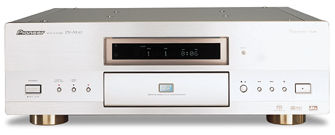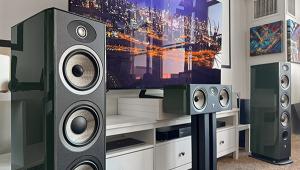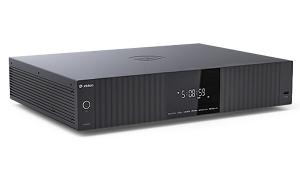Progressive-Scan or Progressive Scam? Page 2
So, maybe there isn't much of a conspiracy going on. While any given sales rep will say that the other manufacturers are using line doublers and not a true progressive output, it really doesn't matter. Recognizing properly coded software and outputting a progressive image are relatively easy. The difference between the so-called true progressive player and the one that properly deinterlaces the image is academic, at best. The real test of a progressive DVD player is the quality of its onboard line doubler that's used for titles that aren't progressive or that can't be read as such.
Pioneer DV-AX10 and DV-434 DVD Players
Is it real progressive, or is it Pioneer?

Pioneer's high-end progressive-scan player, the DV-AX10, has excellent build quality and comes in an attractive champagne finish.
The difference between a Mercedes and a Honda Accord is entirely dependent on the point of view of the owner. One might be seen as a cheaply made economy car or an incredible bang for the buck. The other might be considered an elegant and luxurious way to travel or an extravagant waste of money and cowhide. The same can be said about many consumer electronics products (except for the cowhide part). The comparison at hand revolves around Pioneer's current crop of DVD players.
Pioneer's lineup of progressive-scan DVD players runs the gamut from stratospheric to dirt cheap. For starters, they offer the high-end DV-AX10, which includes their Pure Cinema mode (aka 3:2 inverse telecine), as well as both DVD-Audio and two-channel SACD playback. It's even available in a champagne finish. On the other side of the spectrum is the entry-level DV-434, a budget DVD player and the least expensive "progressive-scan" player I've seen so far. It, however, is the only progressive player that I know of that lacks 3:2-pulldown detection, which means that it doesn't recognize the 3:2 field sequence of film-originated DVDs. Since it's this film mode that allows us to label DVD players as progressive-scan, this player could more accurately be described as simply having an inexpensive line doubler. This doesn't mean the player is without merit, but it doesn't deserve to be called a progressive-scan DVD player.

The DV-AX10's back panel offers all the connections you'll need to incorporate it into any system, including 5.1 analog outputs.
Let's cover the basics first. You can quickly see where Pioneer saved some money on the DV-434. It comes equipped with a bare-bones complement of rear-panel outputs. For example, there's a single set of analog audio outputs that are always active for your Pro Logic receiver, which you should have replaced already. The player does offer both optical and coaxial digital outputs. This gives you options for delivering the Dolby Digital, DTS, and two-channel 24-bit/96-kilohertz signals (not DVD-Audio) to a 5.1 receiver or processor. A switch enables either the composite and S-video outputs or the component connection, but not all three at once. Also, the component connection must be configured for either interlaced or progressive output via the onscreen menu. This isn't difficult to do, just a hassle if the player is set up for one mode and your TV is expecting another. You'll have to use the composite output to set the menu and then switch back to component. There is, at least, a detachable power cord, even though it's of the two-prong variety.
 The DV-AX10, on the other hand, exudes the class and build quality of a high-end component. For starters, it must weigh about 12,000 pounds (52, to be exact). On top of that, it includes a three-prong detachable power cord. Woo-hoo! Seriously, though, the back panel is littered with connectors, which makes the product flexible enough to fit into any sys-tem. First of all, all of the video outputs are active at the same time. In addition, there are dual sets of composite and S-video connectors. Run one set to the display and another to an RF modulator that distributes TV signals throughout the house. The component output, with its more-professional BNC connector, can be switched to either interlaced, progressive, or menu-selectable output.
The DV-AX10, on the other hand, exudes the class and build quality of a high-end component. For starters, it must weigh about 12,000 pounds (52, to be exact). On top of that, it includes a three-prong detachable power cord. Woo-hoo! Seriously, though, the back panel is littered with connectors, which makes the product flexible enough to fit into any sys-tem. First of all, all of the video outputs are active at the same time. In addition, there are dual sets of composite and S-video connectors. Run one set to the display and another to an RF modulator that distributes TV signals throughout the house. The component output, with its more-professional BNC connector, can be switched to either interlaced, progressive, or menu-selectable output.
On the audio side, the DV-AX10 has one optical and two coaxial digital outputs. I'm not even sure why you'd need the third output, but I appreciate its existence, nonetheless. Like the DV-434, the DV-AX10 offers Dolby Digital, DTS, and two-channel 24/96 digital output capabilities. Unlike the DV-434, the DV-AX10 offers DVD-Audio. The analog outputs offer both balanced and sturdy unbalanced connections for the left and right channels. The center, surround, and LFE channels use well-mounted unbalanced connectors, as well. Keep in mind that, while this player has 5.1 outputs, the SACD playback is in two-channel only. Our review sample was equipped with a preproduction DVD-Audio processor that only allowed it to play a handful of the available DVD-Audio titles. Of course, there aren't much more than a handful of DVD-Audio discs, anyway. Shipping units include full DVD-Audio capabilities. I didn't review the audio portion of this player—partly due to this lack of complete DVD-Audio capabilities, partly because 5.1 SACD makes more sense than the two-channel version, and partly because, quite frankly, I was more interested in using the players to describe the difference in progressive output. I applaud Pioneer, however, for having included both audio formats in the same player, and I eagerly hope for an update that includes multichannel SACD.
- Log in or register to post comments


























































